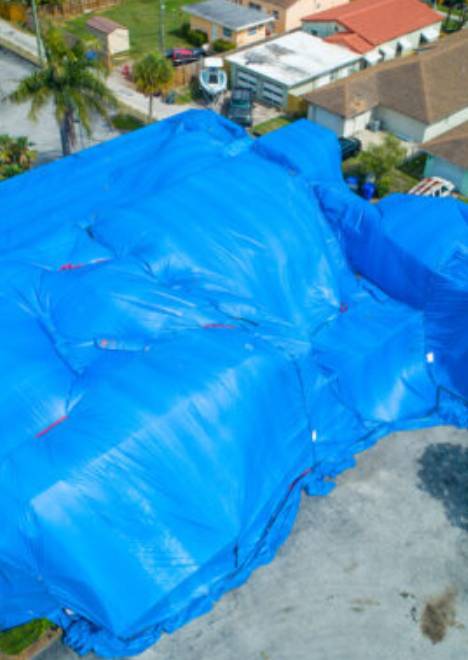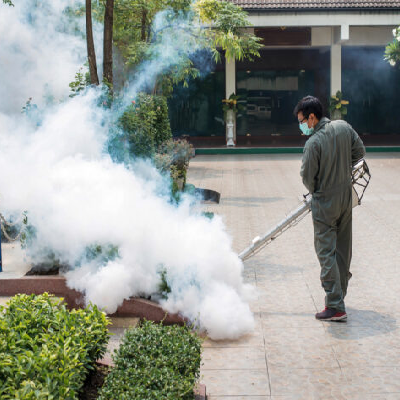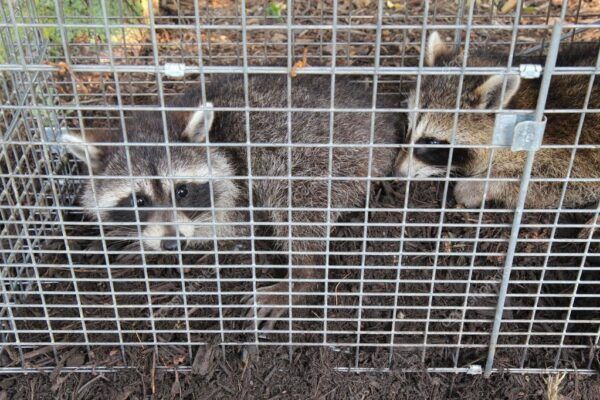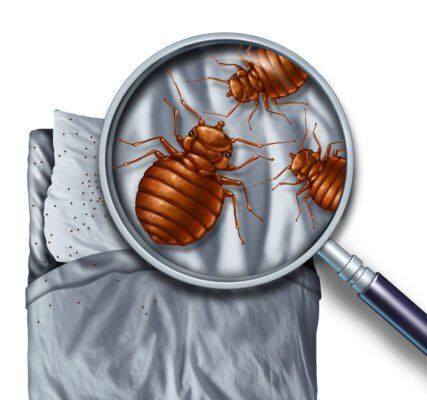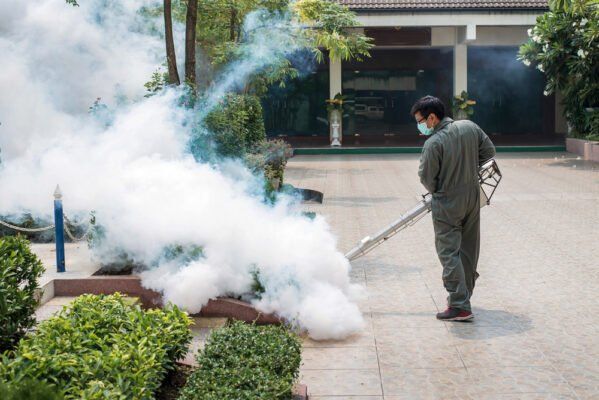Stinging Insect control
VISIT ALLFLORIDABEEREMOVAL.COM
The Stinging Insect Experts
The AllFloridaBeeRemoval.com team members are the recognized experts in stinging insect control in Florida.
Our team consists of University of Florida graduate entomologists, state certified pest control operators & registered beekeepers. We provide Bee Removal from residences, buildings, trees, boats, signs, airplanes..anywhere !!! And with over 50 Years of combined stinging insect experience, Graduate Entomologists, you can be assured of great quality.

( ``KILLER BEE`` ) AFRICAN HONEY BEES
Honey bees are comprised of races (or subspecies) of which the African Honey Bee (scutellata) is one. This is the subspecies that media has dubbed ” Killer Bee”.Nearly identical in appearance to the races of European Honey Bee, the only reliable method of identification is by genetic analysis or comparison of wing size. The behavior of the African bee IS very different from its European cousin. They will nest ANYWHERE. Water meter boxes are a very common nesting site.
Africanized honey bees are dangerous stinging insects that have been known to chase people for more than a quarter of a mile once they get excited and aggressive. This is why they earned the nickname “killer bee.”
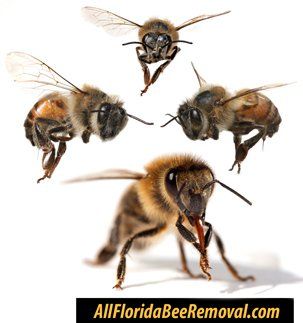
(APIS MELLIFERA) EUROPEAN HONEY BEE
Honey bee are social insects, and their colonies can have upwards of 20,000 to 80,000 individuals. They are raised for honey and beeswax, and are essential for pollination of many crops. The stinger has barbs, so that the stinger and the poison sac remain in the skin. Unlike wasps, honey bees can sting only once.
If a honeybee swarm is left and not collected quickly (within the same day), it could colonize your property chimney, roof or wall. We strongly advise you get the swarm removed quickly to prevent the risk of having a bee colony to deal with – not just a bee swarm…
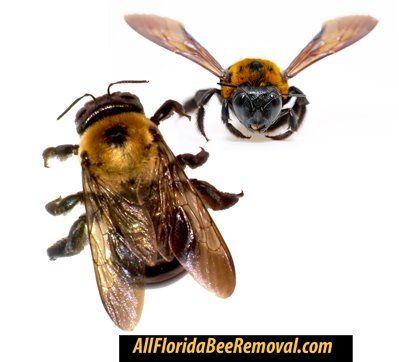
(XYLOCOPA SPP) CARPENTER BEE
Similar in appearance to Bumble bees, but the abdomen is ‘naked’, not covered in hair. Generally considered to be non-aggresive, but during the spring, males are known to ‘buzz’ you if you get too close to galleries. Carpenter bees are solitary, with each female provisioning a gallery that she bores into wood.
The most common signs of a carpenter bee infestation are the round, smooth holes that carpenter bees bore into wood. To identify early damage to buildings, homeowners should regularly inspect the perimeter of the home and surrounding property for the presence of these holes and hovering bees.
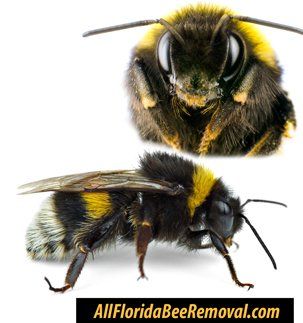
(BOMBUS) BUMBLEBEE
Most bumble bees are large, social bees which produce annual colonies. Mated queens overwinter in the soil and emerge from hibernation in early spring when they feed on spring flowers and search for a suitable location, such as a former rodent burrow in the soil, to begin their colonies. These are beneficial insects that pollinate many native and ornamental plants. They can sting severely, so problem nests near human dwellings should be removed by experienced pest control operators.
Bumble bees are easily recognized by the corbicula (pollen basket) on the hind tibiae in the females. Honey bees are the only other bees in Florida with this structure, but are easily recognized by their smaller size, hairy eyes, and lack of hind tibial spurs.
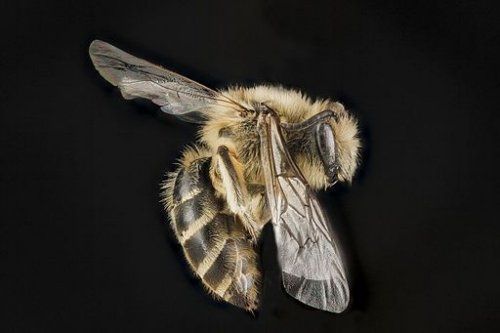
MINER BEES GROUND NESTING
Ground nesting or miner bees are solitary bees that create underground galleries, with queens living individually and raising their own young. The entrances to the nests are small piles or patches of bare soil. They do not form hives, but several females may nest in the same area. Ground bee queens do not defend their nesting areas and are very docile and unlikely to sting, posing little or no threat to people. The males often patrol an area inhabited by females seeking mates. While the males can be very active and seem aggressive, they lack a sting and are also harmless.
If you feel you must get rid of ground bees even for the brief time they live in your lawn, there is no need to use pesticides of any kind. Ground bees prefer dry soil to nest in, and simply watering the area that they have chosen will cause them to move to another area.
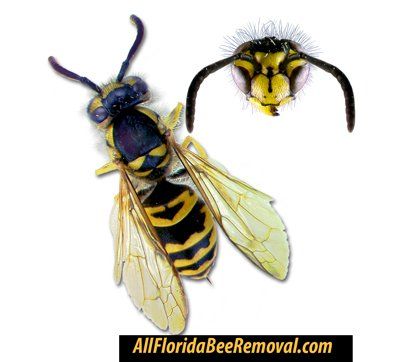
( VESPULA MACULIFRONS ) FLORIDA YELLOW JACKET
Similar to most other hornets, it makes its nest above ground. In general, the term “hornet” is used for species which nest above ground and the term “yellowjacket” for those which make underground nests, often at the base of trees or under shrubbery in loose soil. Occasionally will build aerial nests, or nests that are placed in hedges, sitting on debri or branches. Will build in structures as well..
Southern Yellowjackets, V. squamosa, are the predominate yellowjacket species in Florida and have multiple queens per colony, sometimes numbering in the hundreds. Because of this reproductive potential, colonies can attain massive size, often numbering over 100,000 individuals.
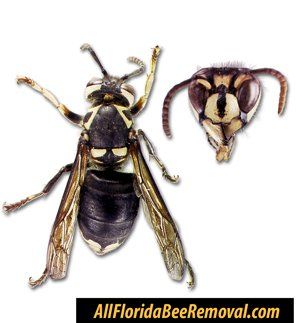
( DOLICHOVESPULA MACULATA ) BALD-FACED HORNET
Dolichovespula maculata is a eusocial wasp of the cosmopolitan family Vespidae. Its colloquial names include the bald-faced hornet, bald hornet, white-faced hornet, white-tailed hornet, spruce wasp, blackjacket, and bull wasp. This species is a yellowjacket wasp, not a true hornet. The hornets that are found in Florida are actually a large Yellow Jacket. Their range extends throughout the U.S. & Canada.
Bald Faced Hornets typically construct aerial nests and can have 150 to about 500 individuals per nest. Nests are constructed of a ‘paper’ that is made by workers chewing cellulose containing materials, usually bark from twigs and branches. Nests are often overlooked until Fall, when foliage drops.
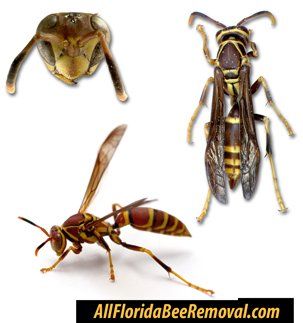
POLISTES CAROLINA (L.) (INSECTA: HYMENOPTERA: VESPIDAE) PAPER WASP, RED WASP
The paper wasps are members of the family Vespidae. In general, they are elongate and slender, characterized by spindle-shaped metasoma and brownish or reddish bodies marked with yellow. Defining features include: forewings with three submarginal cells and no intersections between the first subdiscoidal and medial cells, mid tibiae with two spurs, wide gena that does not taper ventrally, simple tarsal claws, clypeus pointed at the apex, a subtly arched (in profile) metasomal tergum 1, and discrete hair covering the head and body. (Source: University of Florida – Entomology & Nematology Department)
Paper wasps build their nests from wood tissue and saliva, pressing the materials with their mandibles into thin, delicate layers resembling paper that form the nest and comb of hexagonal brood cells. Typically nests are attached by a pedicel to the protected underside of overhanging structures, such as the eaves of houses or in hollows of trees.
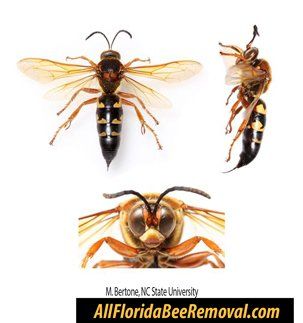
SPHECIUS SPECIOSUS (DRURY) (INSECTA: HYMENOPTERA: SPHECIDAE) CICADA KILLER, GIANT GROUND HORNET
Cicada killers, or giant ground hornets, are among the largest wasps in Florida (up to 40 mm in length). Body predominately black with first three abdominal segments with large yellow spots; legs, mesoscutellum, and part of vertex rust orange color. The females of the common Florida species, Sphecius speciosus (Drury), hunt Tibicen spp. cicadas and can dig 4-foot burrows in the ground with several branches and cells.
(Source: University of Florida – Entomology & Nematology Department)
Sometimes common locally in Florida especially during the summer months where many wasps may nest together gregariously. Human encounters with this giant wasp are only seemingly dangerous since usually it is the stingless male which is the aggressor.
Image source: (M. Bertone, NC State University)
Did you knowthat not all bee removal firms really know bees and other stinging insects?It’s true, most pest control company technicians or beekeepers don’t have the knowledge to properly locate, treat and remove a bee infestation.
SERVICES
Pest Management
SERVICES
Termite Control
SERVICES
Wildlife Control
SERVICES
Bed bug control
SERVICES
Mosquito Control



